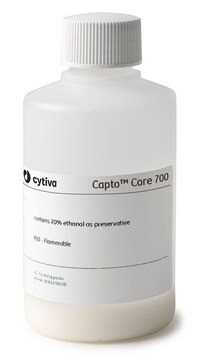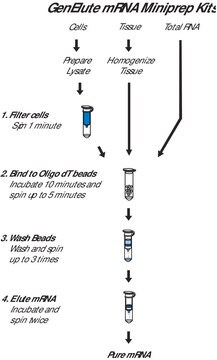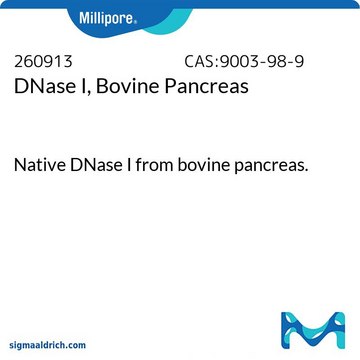DNASE70
On-Column DNase I Digestion Set
sufficient for 70 preparations
Synonym(s):
Deoxyribonuclease I Set
Sign Into View Organizational & Contract Pricing
All Photos(1)
About This Item
UNSPSC Code:
12352204
NACRES:
NA.52
Recommended Products
grade
for molecular biology
Quality Level
form
liquid
usage
sufficient for 70 preparations
technique(s)
RNA purification: suitable
storage temp.
−20°C
Looking for similar products? Visit Product Comparison Guide
General description
The On-Column DNase I Digestion Set offers a simple and convenient method for eliminating genomic DNA from total RNA preparations. This Set is intended for use with the GenElute™ Mammalian Total RNA Miniprep Kit and the Spectrum Plant Total RNA Kit. It can also be used with many other commercially available RNA purification kits.
The vast majority of DNA is eliminated from total RNA purifications by the procedures provided in the standard protocols of the Sigma Kits named below. However, for very sensitive applications, such as quantitative RT-PCR, even trace amounts of DNA can result in false positive detection of cDNA-derived amplicons.
The On-Column DNase I Digestion Set offers a simple and convenient method for eliminating genomic DNA from total RNA preparations. This Set is intended for use with the GenElute™ Mammalian Total RNA Miniprep Kit, the GenElute Bacterial Total RNA Purification Kit, the GenElute Yeast Total RNA Purification Kit and the Spectrum™ Plant Total RNA Kit. However, the digestion protocol is compatible with many other commercially available RNA purification kits.
The term ′On-Column′ indicates that digestion is accomplished in-process for true convenience. Each of Sigma′s total RNA purification kits utilize a binding column for purification. DNase I digestion is accomplished in 15 minutes while total RNA is bound to the column substrate. Several wash steps and elution of the total RNA immediately follow. To review the complete protocol, see the Technical Bulletin for any of the Kits named above.
The On-Column DNase I Digestion Set offers a simple and convenient method for eliminating genomic DNA from total RNA preparations. This Set is intended for use with the GenElute™ Mammalian Total RNA Miniprep Kit, the GenElute Bacterial Total RNA Purification Kit, the GenElute Yeast Total RNA Purification Kit and the Spectrum™ Plant Total RNA Kit. However, the digestion protocol is compatible with many other commercially available RNA purification kits.
The term ′On-Column′ indicates that digestion is accomplished in-process for true convenience. Each of Sigma′s total RNA purification kits utilize a binding column for purification. DNase I digestion is accomplished in 15 minutes while total RNA is bound to the column substrate. Several wash steps and elution of the total RNA immediately follow. To review the complete protocol, see the Technical Bulletin for any of the Kits named above.
Application
On-Column DNase I Digestion Set is suitable for removing gDNA from total RNA preparations. It may not be suitable for RT-PCR applications as a small amount of residual DNA may remain. On-Column DNase I Digestion Set was used to purify RNA preparations isolated from Vitis vinifera cultivars.
Features and Benefits
The On-Column DNase I Digestion Set offers a simple and convenient method for eliminating genomic DNA from total RNA preparations. This Set is intended for use with the GenElute™ Mammalian Total RNA Miniprep Kit, the GenElute Bacterial Total RNA Purification Kit, the GenElute Yeast Total RNA Purification Kit and the Spectrum™ Plant Total RNA Kit. However, the digestion protocol is compatible with many other commercially available RNA purification kits.
Principle
The on-column digestion is accomplished in-process for convenience. DNase I digestion is accomplished in 15 minutes while total RNA is bound to the column substrate. Several wash steps and elution of the total RNA immediately follow.
Legal Information
GenElute is a trademark of Sigma-Aldrich Co. LLC
Spectrum is a trademark of Sigma-Aldrich Co. LLC
related product
Product No.
Description
Pricing
Signal Word
Danger
Hazard Statements
Precautionary Statements
Hazard Classifications
Resp. Sens. 1
Storage Class Code
10 - Combustible liquids
WGK
WGK 3
Certificates of Analysis (COA)
Search for Certificates of Analysis (COA) by entering the products Lot/Batch Number. Lot and Batch Numbers can be found on a product’s label following the words ‘Lot’ or ‘Batch’.
Already Own This Product?
Find documentation for the products that you have recently purchased in the Document Library.
Customers Also Viewed
Michal Bukowski et al.
Nature communications, 4, 2012-2012 (2013-06-19)
Toxin-antitoxin systems were shown to be involved in plasmid maintenance when they were initially discovered, but other roles have been demonstrated since. Here we identify and characterize a novel toxin-antitoxin system (pemIKSa) located on Staphylococcus aureus plasmid pCH91. The toxin
Carmen Michán et al.
FEMS yeast research, 9(7), 1078-1090 (2009-08-26)
We report the absolute transcription profiles of 24 genes coding for putative thioredoxin (Trx)- and glutathione (GSH)-dependent redox system components, accompanying the Candida albicans batch culture growth, under either yeast or hyphal conditions. All mRNAs investigated (plus the housekeeping ACT1)
Hubert Sytykiewicz et al.
International journal of molecular sciences, 21(17) (2020-09-04)
Thioredoxins (Trxs) and thioredoxin reductases (TrxRs) encompass a highly complex network involved in sustaining thiol-based redox homeostasis in plant tissues. The purpose of the study was to gain a new insight into transcriptional reprogramming of the several genes involved in
Filipa Monteiro et al.
PloS one, 8(9), e72998-e72998 (2013-09-12)
The pivotal role of cultivated grapevine (Vitis vinifera L.) in many countries economy is compromised by its high susceptibility to Plasmopara viticola, the causal agent of downy mildew disease. Recent research has identified a set of genes related to resistance
Roxana-Olimpia Gheorghe et al.
Cellular and molecular neurobiology, 40(6), 1011-1027 (2020-01-18)
Iba1 (ionized calcium binding adapter protein 1) is a cytoskeleton protein specific only for microglia and macrophages, where it acts as an actin-cross linking protein. Although frequently regarded as a marker of activation, its involvement in cell migration, membrane ruffling
Our team of scientists has experience in all areas of research including Life Science, Material Science, Chemical Synthesis, Chromatography, Analytical and many others.
Contact Technical Service










